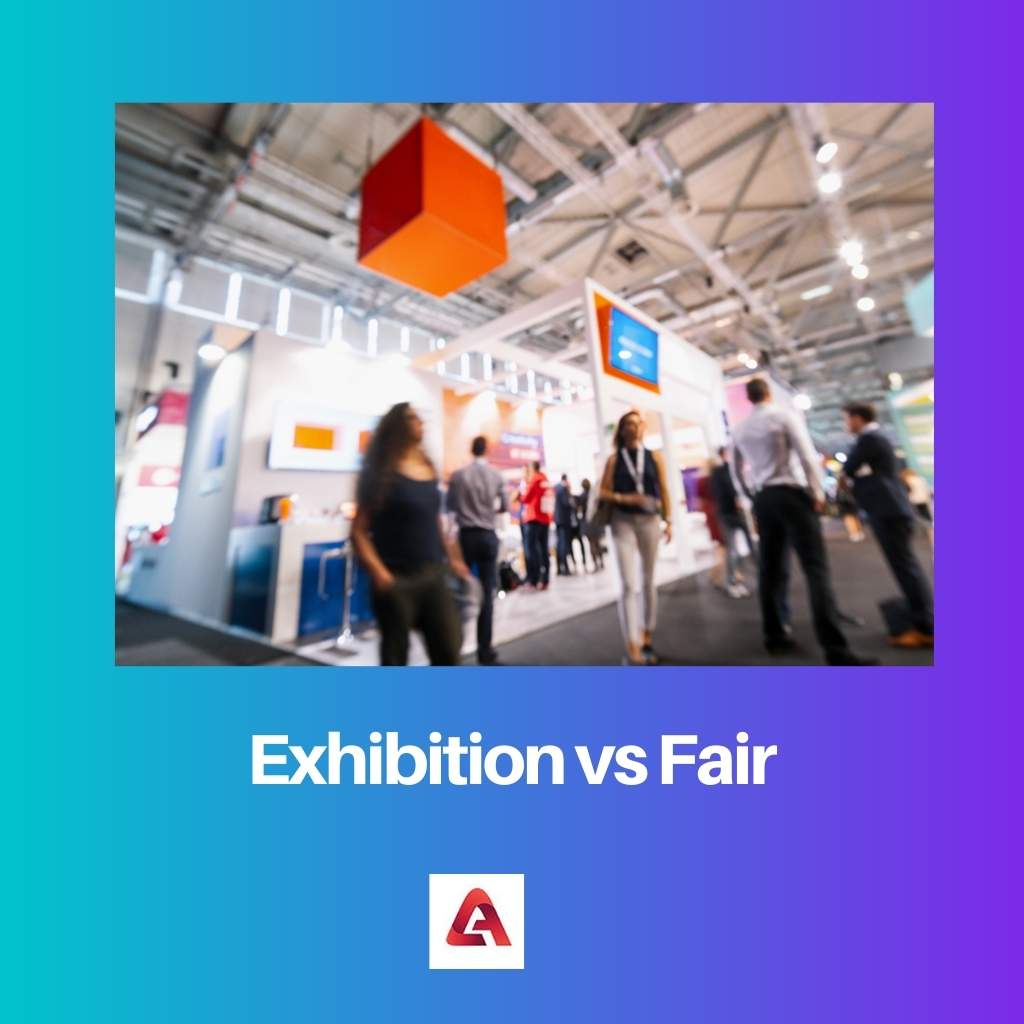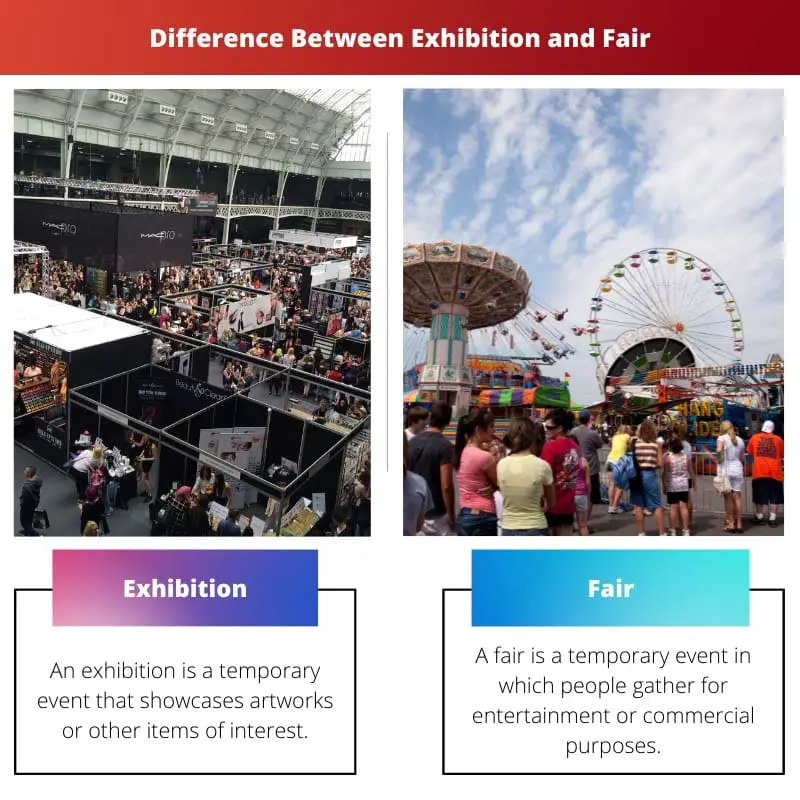Exhibition and fair are two terms that describe a temporary public event that may occur anywhere globally. They are held with the purpose of showcasing something, educating people or simply entertaining them.
It is confusing to tell them apart due to their overlapping characteristics. However, there are quite a few differences between them.
Key Takeaways
- Exhibitions showcase products, art, or ideas, while fairs involve buying, selling, and entertainment.
- Exhibitions can be specialized or general, whereas fairs cater to broader interests and attract diverse crowds.
- Fairs have a festive atmosphere, while exhibitions may be more formal and structured.
Exhibition vs Fair
Exhibition is an event in which artworks and other interesting items like photographs, historical objects, sculptures and local crafts are showcased to the public. Fair is an event where people gather, mostly outdoors, for different commercial activities, sales and entertainment shows.

An exhibition is an event where artworks or other items of interest are showcased to the public. These are held in museums, art galleries or trade fairs.
The showcased items may include paintings, photographs, historical objects, sculptures, mechanical objects, local crafts and much more.
The term ‘fair’ is used to describe an event in which people gather for several commercial activities and for entertainment purposes.
These are held outdoors. Most of the time, an exhibition can be a small part of a fair. However, a fair can never be called an exhibition.
Comparison Table
| Parameters of Comparison | Exhibition | Fair |
|---|---|---|
| Meaning | An exhibition is a temporary event that showcases artworks or other items of interest. | A fair is a temporary event in which people gather for entertainment or commercial purposes. |
| Display | Exhibitions have a single theme where the works of a particular artist are displayed. | Fairs include several products and services that belong to different people. |
| Trading | Only some exhibitions are meant for the sale of products. | Fairs always have a commercial aspect as they contain booths that sell food, souvenirs and much more. |
| Entertainment | The main goal of most exhibitions is to educate and not entertain. | Fairs comprise a major element of recreation and entertainment. |
| Location | Exhibitions are mostly held in museums, art galleries or trade fairs. | Fairs are always held outdoors. |
What is Exhibition?
An exhibition is a temporary event that involves an organized presentation of artworks or other items of interest. These events are mostly held in places that have a cultural or educational environment.
Museums, libraries, art galleries and exhibition halls are some trademark locations where exhibitions are held.
Their primary objective is to spread information about the items displayed.
These items may or may not be available for sale. Some common constituents of an exhibition include paintings, historical artefacts, machines, robots, sculptures, dresses, etc.
These may be the work of a single person or a group of people who agree on one single theme for the event.
Exhibitions are planned, organized, and carried out with the help of several people. These people are a team of specialists whose job is to ensure the smooth functioning of the event.
Curators selectively choose the items that are meant to be displayed. The labels and printed material that is used to inform people about the items need to be written by writers and editors.
Moreover, several architects and designers are given the responsibility of creating an ideal space where the event can be held. Furthermore, the planning and organizing part of it is done by event planners, managers, and a logistics team.

What is Fair?
A fair is a temporary event in which people gather for recreational, entertainment or commercial purposes. These events may be held for a day or several weeks.
Many people own booths in the event through which they sell food, accessories, souvenirs, or other objects. These booths could even be used for organizing games, quizzes, competitions, and other recreational activities.
The concept of fairs started back in ancient Rome, where people were given a holiday break from working as a labour and from pleadings. Later, fairs held in the Middle Ages were more like markets where people from different countries or continents could sell unique products.
Some fairs even included sales of live animals such as horses, lamb, and sheep. Nowadays, fairs are held to celebrate or steam off from daily life for a while.
Fairs could be of many kinds. Some common ones include trade fairs, county fairs, village fairs, temple fairs, carnivals, state fairs, street fairs and festivals.
However, many a time, the large number of people who gather at these events may impend chaos, disorder, or sometimes even riots.
Thus, it is safe to have a certain authority who looks over the working of the event and ensures that everything is in place a all times.

Main Differences Between Exhibition and Fair
- An exhibition showcases artworks or other items of interest, whereas a fair is an event where people gather for recreational or commercial purposes.
- Exhibitions have a single theme set by a particular artist, whereas fairs include several themes while offering different products and services.
- Not all exhibitions involve trading, whereas all fairs involve some form of trading.
- Exhibitions are not meant for entertainment, while fairs are meant for entertainment.
- Exhibitions are held indoors, while fairs are always held outdoors.

- https://www.tandfonline.com/doi/abs/10.1080/00343409850123026
- https://economy.spbstu.ru/en/article/2018.71.7/

I appreciate the comprehensive information about the functions and history of both exhibitions and fairs. The examples provided in the article give a clear understanding of the differences between these types of events.
This article provides a well-documented analysis of the differences between exhibitions and fairs, and the historical background offers valuable insights. The inclusion of references adds to the credibility of the content.
The article presents a comprehensive comparison between exhibitions and fairs, drawing out the key differences. The distinctions made about the locations of these events are particularly interesting.
There is definitely an important distinction to make between these two types of events. It’s good to have it clarified. I would like to know more about the origins of fairs, as it’s mentioned briefly in the article.
The comparison table is very detailed and allows for a clear understanding of the differences between exhibitions and fairs. The historical context of fairs is also very interesting.
The comprehensive explanations help in understanding the differences between exhibitions and fairs. The references provided also add credibility to the content.
The article explains very well the difference between the two very similar terms and offers a comprehensive comparison. It is interesting to see how exhibitions are meant for education and fairs are meant for entertainment and trading.
The explanations regarding exhibitions and fairs are well articulated in this article. The historical aspect and the update on current types of fairs make it stand out.